US Government Criticizes NYT for Coverage of Kashmir Terror Attack
US Government Criticizes NYT for Coverage of Kashmir Terror Attack
Background of the Incident
The New York Times (NYT) recently published an article covering a terror attack in Kashmir, which has sparked controversy and criticism from the US government. The attack, which took place in a region long fraught with tension, has drawn international attention and varying perspectives on its implications.
US Government’s Concerns
The US government has expressed dissatisfaction with the NYT’s portrayal of the incident, citing several key issues:
- Bias in Reporting: Officials argue that the article displayed a bias that could mislead readers about the nature and context of the attack.
- Lack of Context: The coverage allegedly failed to provide sufficient historical and geopolitical context, which is crucial for understanding the complexities of the Kashmir conflict.
- Impact on US-India Relations: Concerns were raised about how such reporting might affect diplomatic relations between the United States and India, a key ally in the region.
Reactions and Implications
The criticism from the US government has sparked a broader discussion about media responsibility and the role of international journalism in conflict zones. Key reactions include:
- Media Responsibility: The incident has reignited debates on how media outlets should balance reporting facts with providing comprehensive context.
- Diplomatic Sensitivity: The situation underscores the importance of sensitive reporting in areas with complex political dynamics.
- Public Perception: The coverage and subsequent criticism may influence public perception of the Kashmir conflict and international relations.
Conclusion
The US government’s criticism of the NYT’s coverage of the Kashmir terror attack highlights the challenges and responsibilities of international journalism. The incident serves as a reminder of the delicate balance between reporting news and maintaining diplomatic relations, emphasizing the need for comprehensive and unbiased media coverage in conflict zones.







































